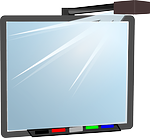 It is so common now, it is just taken for granted. In any lecture, presentation, or sales pitch, the obligatory 5 minute scramble to get the technology working; the dimmed lights to focus all eyes on the screen, the speaker with his back turned to his audience, eyes fixed admiringly on his own slides; the careful reading out of what everyone has already seen for themselves: Powerpoint.
It is so common now, it is just taken for granted. In any lecture, presentation, or sales pitch, the obligatory 5 minute scramble to get the technology working; the dimmed lights to focus all eyes on the screen, the speaker with his back turned to his audience, eyes fixed admiringly on his own slides; the careful reading out of what everyone has already seen for themselves: Powerpoint.
Why not in preaching? We try to hold people’s attention for 30-40 minutes, far longer than most oral presentations; surely if Powerpoint is needed anywhere, we in the Christian Church should be adopting it as well. Technology after all is a welcome thing, and most churches now benefit from microphones, hearing loops, audio recordings and often live streaming. Why just the spoken word? Why nowhere for the eye to rest but on the preacher himself?
The answer is partly one of distraction. Preaching is an intensely personal communication. We are not advertising a vacuum cleaner, or analyzing the roots of the Punic Wars; we are telling you that you have sinned in the sight of God, that you need the way of eternal salvation, and that this text before has a direct message that requires change in your life. A message this important cannot be delegated to a projector and whiteboard: I need, as a preacher, to look into your eyes and tell you these things.
But it is more than that: preachers need to beware creating sermons that are just bullet point constructions. You know the type, the classic Powerpoint slide: a heading at the top; several sub-points, loosely related; a dubious illustration; and some irrelevant visual effects, to distract from the paucity of what is actually being served up. That may do it in the commercial world, though see this excellent article for a good warning against the dangers, but it is not good enough in preaching.
The best preaching involves sustained and developed trains of thought, one proposition following another, proved from Scripture, illustrated from life (if necessary), with building momentum and cumulative force. Ultimately it reaches its conclusion in pressing, urgent practical application, dealing with the critical realities of life and relationship with God.
Preaching does not merely aim to instruct, it seeks to touch, to move, to impact. This involves moments of real intensity and power, which can even take the preacher by surprise. I had this experience just last night, preaching (what I thought was) a routine sermon on an apparently prosaic text, completing a series on Titus with a final address on 3:15. Even in the act of preaching it, the text became more powerful, more intensely personal to us as a congregation, than I had imagined. Powerpoint could only have weakened and blunted that experience.
But how then can we respond to those troubled by distraction during sermons, often taking little home with them? Those who know a visual representation of the sermon structure would help clarify for them where the preacher has come from, and where he is going (and who perhaps suspect that it may help remind the preacher of that as well)? Even as a minister, I have to confess this is quite frequently my situation as well when listening to the sermons of others: that my mind wanders, my attention is distracted, I lose track of the message, and the result is that little sticks and that little benefit is derived from the experience.
But there is a solution to this, one that I have proved over many years. If (like me) you are a visual learner, and you need a visual representation of the message: make your own. Take notes. Even now, I find the difference between taking notes and not taking notes is often the difference between following, engaging, and benefiting from a sermon, and a largely wasted experience. Some people may disapprove and think it unspiritual to take notes in church on a pad or phone; ignore them. The issue is too important. Focus your mind however you need to, because hearing the preaching of God’s Word is the most important activity of your week.
All this said, the other side of the equation follows, of course. If we preachers won’t make sermons predictable and convenient with Powerpoint, then we have to seize and hold the attentions of our hearers ourselves, with the interest, relevance and importance of our subject matter. Sermons without distraction need to be worthy of undistracted attention.


Leave a Reply